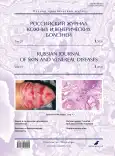Характеристика Т-лимфоцитов различных рецепторных фенотипов у больных псориазом в процессе лечения
- Авторы: Кочергин Н.Г.1, Парамонов А.А.1, Каюмова Л.Н.1
-
Учреждения:
- ФГАОУ ВО «Первый Московский государственный медицинский университет им. И.М. Сеченова» Минздрава России (Сеченовский Университет)
- Выпуск: Том 23, № 1 (2020)
- Страницы: 35-38
- Раздел: КЛИНИКА, ДИАГНОСТИКА И ЛЕЧЕНИЕ ДЕРМАТОЗОВ
- URL: https://journals.rcsi.science/1560-9588/article/view/41726
- DOI: https://doi.org/10.17816/dv2020135-38
- ID: 41726
Цитировать
Аннотация
В инициации и развитии псориатического воспаления участвуют клетки иммунной системы и цитокины. Роль субпопуляций Т-клеток при псориазе до конца не выяснена. В нашей работе представлены результаты исследования по определению уровня, фенотипа и клинической значимости основных субпопуляций Т-клеток в периферической крови больных псориазом при различных видах терапии. Под наблюдением находились 68 больных псориазом (30 мужчин и 38 женщин), которые были разделены на две группы в зависимости от проводимого лечения (селективная фототерапия или комбинация метотрексата с селективной фототерапией). Здоровые добровольцы (10 мужчин и 12 женщин) были включены в качестве контрольной группы. Были определены субпопуляции Т-клеток (CD3+, CD4+, CD8+, Treg) методом проточной цитометрии, показатели интерлейкинов (IL-1β, IL-2, IL-6, TNFα, IFNγ) изучали с помощью иммуноферментного анализа. Для оценки степени тяжести и распространенности псориаза у пациентов использовали индекс PASI и дерматологический индекс качества жизни (ДИКЖ). Выявлена корреляция умеренной силы между PASI и показателями Treg (R = -0,38), CD3+ (R = -0,30), CD4+ (R = -0,32), CD8+ (R = 0,42). Значимая корреляция между ДИКЖ и значениями клеток Treg (R = -0,38), CD3+ (R = -0,30), CD4+ (R = -0,35), CD8+ (R = 0,35) свидетельствует о тенденции к восстановлению баланса клеточных субпопуляций лимфоцитов в процессе терапии. Более выражена данная тенденция была в группе, где для лечения псориаза применяли комбинацию метотрексата с селективной фототерапией.
Ключевые слова
Полный текст
Открыть статью на сайте журналаОб авторах
Н. Г. Кочергин
ФГАОУ ВО «Первый Московский государственный медицинский университет им. И.М. Сеченова» Минздрава России (Сеченовский Университет)
Email: paramonov_aleksey@mail.ru
ORCID iD: 0000-0001-7136-4053
Кафедра кожных и венерических болезней им. В.А. Рахманова
Россия, 119991, г. МоскваА. А. Парамонов
ФГАОУ ВО «Первый Московский государственный медицинский университет им. И.М. Сеченова» Минздрава России (Сеченовский Университет)
Автор, ответственный за переписку.
Email: paramonov_aleksey@mail.ru
ORCID iD: 0000-0002-0441-314X
соискатель кафедры кожных и венерических болезней им. В.А. Рахманова
Россия, 119991, г. МоскваЛ. Н. Каюмова
ФГАОУ ВО «Первый Московский государственный медицинский университет им. И.М. Сеченова» Минздрава России (Сеченовский Университет)
Email: paramonov_aleksey@mail.ru
ORCID iD: 0000-0003-0301-737X
Кафедра кожных и венерических болезней им. В.А. Рахманова
Россия, 119991, г. МоскваСписок литературы
- Dogra S., Mahajan R. Psoriasis: Epidemiology, clinicalfeatures, co-morbidities, andclinicalscoring. Indian Dermatol. Online J. 2016; 7(6): 471–80.
- Elyoussfi S., Thomas B.J., Ciurtin C. Tailored treatment options for patients with psoriatic arthritis and psoriasis: review of established and new biologic and small molecule therapies. Rheumatol. Int. 2016; 36(5): 603–12.
- Siegel D., Devaraj S., Mitra A., Raychaudhuri S.P., Raychaudhuri S.K., Jialal I. Inflammation, atherosclerosis, andpsoriasis. Clin. Rev. Allergy Immunol. 2013; 44(2): 194–204.
- Притуло О.А., Рычкова И.В. Современные представления о патогенезе псориаза. Таврический медико-биологический вестник. 2017; 20(1): 141–53.
- Lowes M.A., Suarez-Farinas M., Krueger J.G. Immunologyofpsoriasis. Annu Rev. Immunol. 2014; 32: 227–55.








